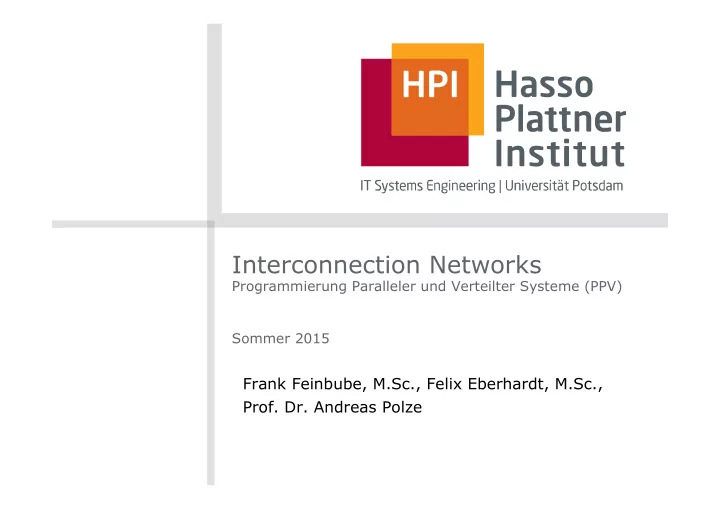

Interconnection Networks Programmierung Paralleler und Verteilter Systeme (PPV) Sommer 2015 Frank Feinbube, M.Sc., Felix Eberhardt, M.Sc., Prof. Dr. Andreas Polze
Interconnection Networks 2 ■ SIMD systems demand structured connectivity □ Processor-to-processor interaction □ Processor-to-memory interaction ■ Static network □ Point-to-point links, fixed route ■ Dynamic network □ Consists of links and switching elements □ Flexible configuration of processor interaction
Interconnection networks Optimization criteria Connectivity – ideally direct links between any two stations High number of parallel connections Cost model Production cost - # connections operational cost – distance among PEs Bus networks, switching networks, point-to-point interconnects 3
Interconnection Networks 4
Interconnection Networks 5 ■ Dynamic networks are built from a graph of configurable switching elements ■ General packet switching network counts as irregular static network [Peter Newman]
Interconnection Networks ■ Network Interfaces □ Processors talk to the network via a network interface connector (NIC) hardware □ Network interfaces attached to the interconnect ◊ Cluster vs. tightly-coupled multi-computer □ SIMD hardware bundles NIC with the processor ■ Switching elements map a fixed number of inputs to outputs □ Total number of ports is the degree of the switch □ The cost of a switch grows as square of the degree □ The peripheral hardware grows linearly as the degree
Interconnection Networks ■ A variety of network topologies proposed and implemented ■ Each topology has a performance / cost tradeoff ■ Commercial machines often implement hybrids □ Optimize packaging and costs ■ Metrics for an interconnection network graph □ Diameter : Maximum distance between any two nodes □ Connectivity : Minimum number of edges that must be removed to get two independent graphs □ Link width / weight : Transfer capacity of an edge □ Bisection width : Minimum transfer capacity given between any two halves of the graph □ Costs : Number of edges in the network ■ Often optimization for connectivity metric
Bus Systems 8 ■ Static interconnect technology ■ Shared communication path, broadcasting of information □ Diameter: O(1) □ Connectivity: O(1) □ Bisection width: O(1) □ Costs: O(p) …
Bus network Optimal #connection per PE: 1 Constant distance among any two PEs 9
Crossbar switch � (Kreuzschienenverteiler) Arbitrary number of permutations Collision-free data exchange High cost, quadratic growth n * (n-1) connection points 10
Crossbar Switch 11
Multistage Interconnection Networks 12 ■ Connection by switching elements ■ Typical solution to connect processing and memory elements ■ Can implement sorting or shuffling in the network routing
Omega Network 13 ■ Inputs are crossed or not, depending on routing logic □ Destination-tag routing: Use positional bit for switch decision □ XOR-tag routing: Use positional bit of XOR result for decision ■ For N PE’s, N/2 switches per stage, log 2 N stages ■ Decrease bottleneck probability on parallel communication
Delta networks Only n/2 log n delta- switches Limited cost Not all possible permutations operational in parallel 14
Delta Networks operation 15 ■ Stage n checks bit k of 0 the destination tag 1 ■ Possible effect of ‚output port contention‘ 2 and ‚path contention‘ 3 4 5 6 7
Clos coupling networks Combination of delta network and crossbar C.Clos, A Study of Nonblocking Switching Networks, Bell System Technical Journal, vol. 32, no. 2, 1953, pp. 406-424(19) 16
Fat-Tree networks PEs arranged as leafs on a binary tree Capacity of tree (links) doubles on each layer 17
Point-to-point networks: � ring and fully connected graph Ring has only two connections per PE (almost optimal) Fully connected graph – optimal connectivity (but high cost) 18
Mesh and Torus Compromise between cost and connectivity 19
Cubic Mesh PEs are arranged in a cubic fashion Each PE has 6 links to neighbors 20
Hypercube Dimensions 0-4, recursive definition 21
Binary tree, quadtree Logarithmic cost Problem of bottleneck at root node 22
Shuffle-Exchange network Logarithmic cost Uni-directional shu ffl e network + bi-directional exchange network 23
Plus-Minus-Network PM 2i – 2*m-1 separate unidirectional interconnection networks 24
Systolic Arrays 25 ■ Data flow architecture ■ Common clock ■ Maximum signal path restricted by frequency ■ Single faulty Problem: common clock – element breaks the complete array faulty processing element
Comparison Bisection Arc Cost Network Diameter Width Connectivity (No. of links) Completely-connected Star Complete binary tree Linear array 2-D mesh, no wraparound 2-D wraparound mesh Hypercube Wraparound k -ary d -cube
Comparison Arc Cost Network Diameter Bisection Width Connectivity (No. of links) Crossbar Omega Network Dynamic Tree
Comparison of networks 28
Recommend
More recommend